Occasionally a design featuring peltae and circle segments appears in Greece. The basic motif of this pattern is a rosette-like ornamentation formed by overlapping circles. Again the mosaic artists make use of a layout featuring quadratically-arranged points (Fig. 35).
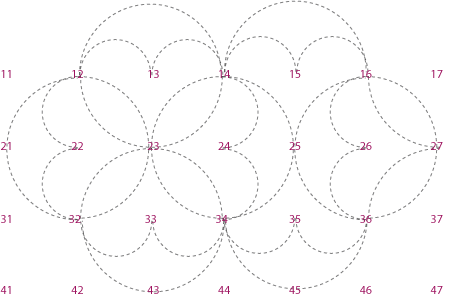 |
Thus there is a fundamental difference to rosette forms in Pompeii and Herculaneum, which are derived from a triangular design and feature seven circles. A six-leaved, so-called “compass-drawn-rosette” is in this case surrounded by six peltae (Fig. 36).
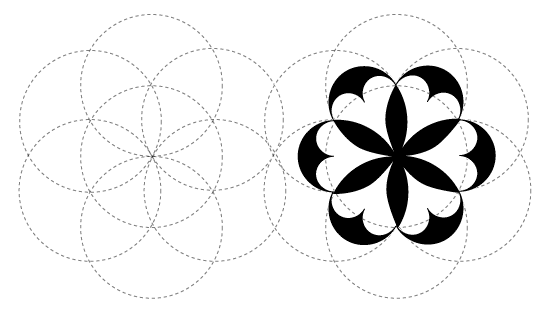 |
The rosettes on Roman-era mosaics in Greece consist of a cruciform and four peltae. The rosettes are lined up in a row, and between them arise heart-shaped or rectangular fields with indented, concave sides. (Fig. 37). The preference is for simple geometric forms without extravagant decoration. In only two cases is the pelta apex decorated with a cross.
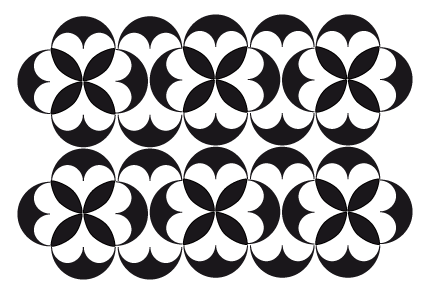 |
The combination of peltae and cruciforms was first established in Greece in Late Antiquity. Of nine pavements, seven can almost certainly be dated to early Christian times. Probably only two mosaics, in Patras and Thasos, date from the 3rd Century AD.
The design appears very rarely on large surfaces or framing areas. Only in Gortyn does it decorate the broad borders of a mosaic floor. Mostly it’s limited to a relatively small segment of the floor and is either complimentary or subordinate to the neighbouring surface designs.
It appears as a filler motif in the quadratic area of a diamond-star mosaic in Thessaloniki dating from Late Antiquity.
In four cases the design appears in black and white.
Another colour (probably red) was used for a mosaic in Patras. According to the published drawing, in each repetition of the pattern two differently coloured peltae lie opposite one another. Between the rosettes are pairs of peltae that touch one another with their convex sides.
The pavement in Gortyn is constructed on the same principle. Here black peltae contrast with lightly coloured cruciforms featuring dark borders.
Only fragments of the pelta design survived in Nikopolis. The mosaic was created by a less talented artist, who was clearly remiss in his use of compasses and stencils. The peltae and cruciforms are irregular in shape, and as a result accidental gaps as well as cases of overlapping arise. Despite the poor condition and inferior quality of the pavement, it’s possible to reconstruct the pattern. In contrast to the mosaics from Gortyn and Patras, in this case cruciforms were apparently set between the rosettes.
There are also repeat patterns featuring cruciforms and peltae that don’t form full four-leaved rosettes (Fig. 38). In two cases the cruciforms are framed by peltae on only three sides. On a mosaic in Thessaloniki cruciforms alternate with back-to-back peltae. Due to a lack of space on an Athenian mosaic, the cruciforms are surrounded by peltae on only three sides.
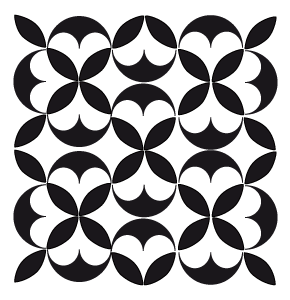 |
Two mosaics in Argos und Thessaloniki show some similarities in the form of their pelta pattern. Unlike in the previous examples, the rosettes consist of eight, rather than four, intersecting circles (Fig. 39).
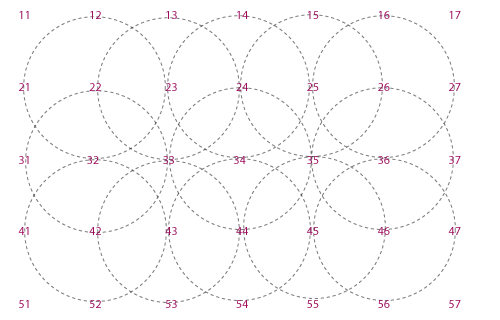 |
In the centre is a cruciform whose tips reach the middle of the circles and there run into the surrounding peltae. The peltae have long, pulled down endings that connect to one another (Fig. 40).
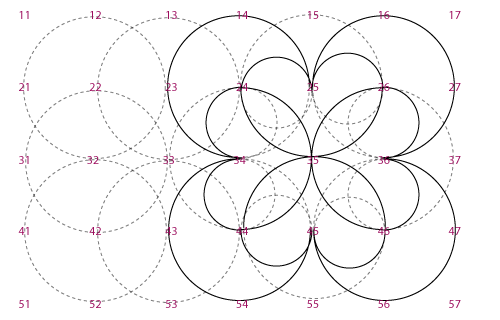 |
In both cases the cruciforms and peltae are left white, while the heart-shaped fields are filled with colour. In Thessaloniki two red and two blue “hearts” are situated opposite one another in each segment. In every second rosette there’s a plaited knot, rather than a cruciform, surrounded by four white peltae. The rosettes have dark contour lines, which lends clarity to the pattern. Small squares with a staircase-like arrangement (“diamonds”) decorate the rectangular fields.
The mosaic in Argos has a similar construction. In this case, however, the design isn’t enriched by additional motifs. Each rosette consists of four cruciforms and four peltae. In the rectangular fields small rosettes with V-shaped leaves appear. The peltae are somewhat rounder-bellied than in Thessaloniki.
 |
It’s possible that a design featuring peltae and cruciforms layered on top of one another also appears in Greece. A small mosaic fragment in Thasos features three touching peltae and lancet leaves which bear no resemblance to an ornamental rosette.